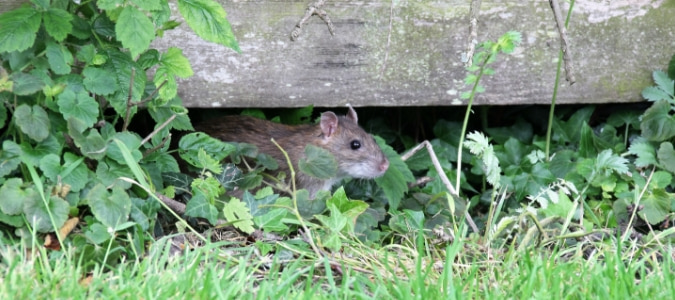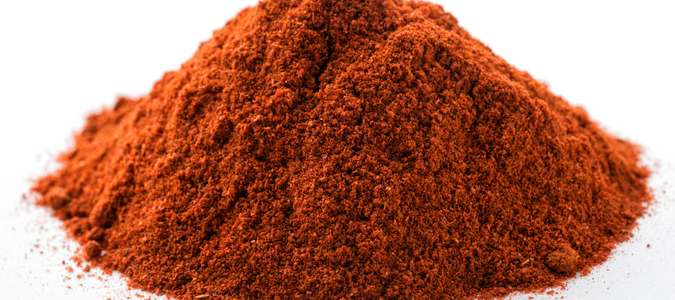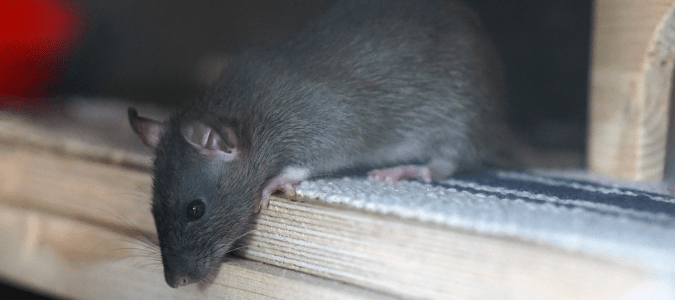Knowing what attracts rats is a big part of keeping them away from your home and property. Rats are wild animals that naturally live outdoors, building nests under shrubbery, inside dead trees or in underground burrows. Like all animals, rats have three basic needs—food, water and shelter. When you’re dealing with a rat infestation on your property, it means they have found all three. This is why a big part of getting rid of rats is eliminating what’s attracting them.
If you’re dealing with a problem, you may notice some of the following signs of rats:
- Scattered rat droppings
- Shredded paper, insulation or other nesting materials
- Squeaking or scratching sounds coming from within the walls or ceilings
- Gnaw marks on cabinets, baseboards or other areas
- Greasy rub marks along walls, baseboards or rafters, where these pests commonly walk along their routes between their nest and their food and water sources
- An actual rat sighting—though this is less common since rats are nocturnal and naturally wary of humans
Rats pose a big problem for homeowners. These rodents carry bacteria and diseases that can cause illness in people and their pets. Rats contaminate any surface they touch, not to mention any human or pet food they consume. Worst of all, their numbers grow quickly because they reproduce so fast. A single female rat can have 50 or more babies in a year. If you think you have a rat problem, it’s important to get it under control as quickly as possible.
Several common things attract rats. It’s important to be able to identify areas around your property that could encourage rats to stick around.
Here are some of the most common things that attract rats:
- Garbage and compost bins without secure lids
- Barbecue grills, especially those with grease traps that aren’t cleaned regularly
- Fallen fruit, nuts, and berries
- Bird seed and other outdoor animal feed
- Clutter, including boxed items stored in garages and attics
- Pet food and water bowls
- Pet waste
In nature, rats typically eat fruits, nuts, and berries, but they are omnivorous. When they infest a home or garage, they will eat just about any type of food they can access. As rodents with instinctive gnawing habits, rats will also chew through wood, cardboard, insulation, PVC pipes, and electrical wiring. While they aren’t technically eating these items, they can cause a lot of damage.
When it’s too hot or cold outside, rats seek out protected shelter that is a more comfortable temperature. Unfortunately, this often means inside people’s homes or garages. Droughts, heat waves, and frozen temperatures can also push rats indoors in search of food and water. For these reasons, it’s important to make your property less appealing to them and cut off their access to indoor spaces.
Cutting Off Access
Though rats can grow pretty big, they can fit through surprisingly small holes. In order to cut off their access to your home, attic, garage, or other indoor space, you’ll need to look for any small openings they may be used to get inside. Gaps around exterior vents and hose bibs are common spots used by rodents and other pests to get into your home. Holes in the eaves or around windows and exterior doors are also common entry points. So are tears in window screens that let pests through.
Close off these openings using steel wool, caulk, or fine-gauge wire mesh. Replace any damaged screens. It’s also wise to check weather stripping, door sweeps, and thresholds on exterior doors and replace them if needed.
You don’t want rats nesting anywhere else on your property, even if they stay outside. Piles of old wood, tires or dead tree limbs are great spots for rats to build nests. So are overgrown bushes and shrubs or hollow tree stumps. Clearing these away and keeping your trees and landscaping trimmed will go a long way toward keeping pests at bay.
Once you have dealt with spots that rats might be using to get inside, it’s time to deal with the food and water sources attracting them. If you have trees that drop fruits or nuts in your yard, it’s a good idea to clear these away regularly so they don’t draw pests. Empty outdoor pet food and water bowls nightly. Garbage and compost bins should have tight-fitting lids that keep pests out.
Inside the home, garbage and compost bins should also be well-covered. Keep any food that isn’t in the refrigerator in airtight containers that rats and other pests can’t get into. Empty all pet food and water bowls at night, so they don’t draw pests of any kind. Also, fix any indoor water problems like leaky faucets or pipes so rats can’t use these for their water needs.
Rats are also attracted to good hiding places, whether they find those indoors or outside. Clearing away clutter inside your home, attic, and garage is another important step in controlling rat populations. Even neatly stored cardboard boxes can harbor rats. If you have a rat problem, it’s best to reduce clutter as much as possible so you won’t unknowingly shelter these pests.
Sometimes, sealing off entry points, clearing away clutter, and eliminating food and water sources aren’t enough. If you’ve taken these steps and are still dealing with rats, it’s time to contact a pest control professional. It’s a good idea to reach out for professional help at the first sign of rats. When dealing with a rodent infestation, time is of the essence. Rat nests can grow exponentially during the time you might spend trying to get rid of them on your own. A pest control exterminator can develop a comprehensive approach to getting your rat problem under control, so you can breathe a sigh of relief.
Does Cayenne Pepper Keep Rats Away?
Does cayenne pepper keep rats away? This is a question some people ask pest control professionals. The urge to find natural, non-toxic pest control methods is understandable. You want to keep your loved ones and pets safe, even when dealing with a rat problem. But rats reproduce quickly and pose many potential problems for people, ranging from illness to property damage. For this reason, it’s usually not a good idea to waste time on ineffective methods that won’t produce the results you need.
Some people do claim to have found success with using cayenne pepper to repel rats. Rats supposedly hate cayenne pepper and will stay away from areas where it is sprinkled. If you have chicken coops on your property that rats are drawn to, sprinkling cayenne pepper around the coops can be a helpful measure. It shouldn’t harm the chickens, and it may repel the rats.
The problem with cayenne pepper and other, similar means of pest control is that they work far better as preventative methods than as control methods. Cayenne pepper isn’t an effective solution for an active rat problem. Contacting a pest control exterminator is the best way to stop a rat infestation or prevent one from occurring.
Can Rats Carry Rabies?
Rats can host several different types of bacteria and illnesses that can make people very sick. But can rats carry rabies? The brief answer is that rats are rarely infected with rabies, and they are not known to transmit rabies to humans. But, rats are still a very real threat to people’s health.
Unfortunately, rabies is just one among many diseases that wild animals can transmit to people. While rats do not pose a rabies threat, they do pose a threat in terms of other diseases that can make people seriously ill. Rats can carry salmonella, for example, as well as disease pathogens including hantavirus, leptospirosis, and plague. This is the same plague that killed millions of people in Europe during the Middle Ages.
Rats can transmit illness to people and their pets directly by biting them, but rat bites are uncommon. Rats are naturally wary of people as well as dogs and other potential predators. These rodent pests are also nocturnal, meaning they are more active at night than during daylight hours. Since it is rare for people to encounter rats, it is also rare for people to get bitten by rats.
The far more common ways that rats transmit illness to people and their pets is through their urine and droppings. Knowing what rat droppings look like can help you quickly identify a problem. Rat droppings are cylindrical and about a half-inch long. These droppings are often found in corners of garages and attics, inside crawl spaces, behind refrigerators, and on top of cabinets.
If rats build a nest in the wall or ceiling, their urine can soak through insulation and drywall. Touching rat droppings or urine can make you sick.
If you find rat droppings, nesting materials, or other signs of rat activity on your property, contact a rodent control expert. A specialist has the knowledge, tools, techniques, and safety protocols needed to deal with a rat infestation safely and thoroughly.
ABC Can Get Rodents Out of Your Home and Garden
It can feel defeating when rats are damaging your home, garden, and yard. Instead of spending your precious time trying to control rodents, contact ABC Home & Commercial Services. Our professionals will be able to identify the rodents on your property. Then, we will create a custom treatment plan, so you don’t have to worry about these creatures.


